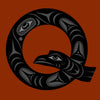Bird with Raised Wings, 1987 by Osuitok Ipeelee (1923-2005)
Regular price
$0.00
Sale
Bird with Raised Wings, 1987
by Osuitok Ipeelee (1923-2005)
Cape Dorset (Kinngait) in Nunavut, Canada
soapstone
13” high x 5” wide x 2” deep
Osuitok was born and raised at Neeouleeutalik camp near the settlement of Cape Dorset (Kinngait) in Nunavut. His early years were spent living off of the land; he married Nipisha in 1946 and moved their growing family into Cape Dorset permanently in the mid 1950s.
When James Houston arrived in Cape Dorset in 1951, Osuitok was already well known as an ivory carver; he had sold his artwork to the local Catholic priest, teachers in Cape Dorset, and the RCMP. His earliest carvings were ivory miniatures of kayaks and fox traps; the very first piece that Ipeelee sold in the 1940s was a "miniature ivory fox-trap with moving parts.
It was Ipeelee's questions about the origins of the printed images on cigarette packages, now an almost legendary story, that set in motion the creation of the Cape Dorset printmaking co-operative. James Houston explained the rudiments of printmaking by rubbing ink onto the surface of one of Ipeelee' tusk carvings and then used toilet paper to lift the resulting impression's image. Upon seeing the result Ipeelee commented: "We could do that."
Osuitok would become instrumental in the development of print making in Cape Dorset. Through the 1950s and onwards he was entrusted with being the "keeper of the carving stone" that he helped quarry during the summer season. This experience, along with his own carving background, helped Ipeelee guide other sculptors to select the best stones. He was well aware of the fracturing, breaking, and cleaving characteristics of the area's stone. Ipeelee remarked: "When I do carvings, most of the time I try and have the stone more like talking to me to tell me if it will work this way."
Considered a sensitive artist, Osuitok's interest in the history of the Inuit and their traditonal culture is reflected in his work. Osuitok's older brother, Sheokjuk Oqutaq (1920-1982) was also a talented artist.
"As a master carver," Ipeelee has said, "I feel proud when young people come talk to me, to learn about what I am doing. It is important for the young people to learn responsibility and provide for themselves."
His caribou sculptures have been described as ghostlike with long, spindly legs. Ipeelee remarked that the inua, or caribou spirits, were quite fragile and were known for being able to make themselves look "handsomer and heavier" when they realized humans were looking at them. Ipeelee ensured that his sculpture would stand balanced by using a carpenter's level. He made the base of the sculpture thicker than it would be in the final product so that he had enough material to work with in the finishing process.
Commenting on the beginning of carving in Cape Dorset Ipeelee, in 1987, observed: "Before the government came up here there was only one way of making money. People could make money from fox furs and the other things we used to bring in, but only a little money. Then it was learned that carvings here in the Arctic have a price and when there were no jobs available people quickly learned their value. That is why they have tried so hard at it"






